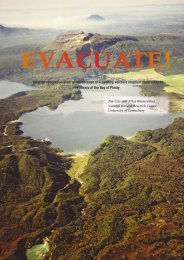Volcanoes - Ministry of Civil Defence and Emergency Management
Volcanoes - Ministry of Civil Defence and Emergency Management
Volcanoes - Ministry of Civil Defence and Emergency Management
Create successful ePaper yourself
Turn your PDF publications into a flip-book with our unique Google optimized e-Paper software.
Crater Lake at Ruapehu viewed from its north side in February 2004.<br />
The lake is nearing its pre-1995 eruption levels as the 2004 winter<br />
begins <strong>and</strong> in future years will rise even further behind a barrier <strong>of</strong><br />
loose debris that covers the outlet area. Photo: Tanya OʼNeill.<br />
date have focused only on the easily recognisable <strong>and</strong><br />
datable large-scale events at each volcano. We know<br />
that these events represent just the “tip <strong>of</strong> the iceberg”<br />
<strong>of</strong> volcanic history; the hidden record <strong>of</strong> minor eruptions<br />
is probably the greatest unknown factor in volcanic<br />
studies in New Zeal<strong>and</strong>. For instance, the eruption<br />
<strong>of</strong> 1995/96 at Ruapehu caused over $130 million<br />
in damage, but was only just a minor “blip” in the<br />
geological record <strong>and</strong> easily overlooked. Filling in the<br />
blanks <strong>of</strong> our geologic records will allow the application<br />
<strong>of</strong> statistical eruption models that have been developed<br />
on other volcanoes around the world, such as in Fiji,<br />
to derive new probabilistic forecasts <strong>of</strong> the likelihood<br />
<strong>of</strong> volcanic activity <strong>of</strong> various types in years to come.<br />
These probabilistic models will be developed for each<br />
volcano, not only for forecasting the chances <strong>of</strong> eruption<br />
onset over any given time-frame, but also for estimating<br />
the chances <strong>of</strong> any particular area being affected by<br />
volcanism in future years.<br />
As well as filling in gaps in our knowledge<br />
<strong>of</strong> recent events at Taranaki/Egmont, Ruapehu <strong>and</strong><br />
Tongariro volcanoes, we also want to know how these<br />
volcanoes began “life” <strong>and</strong> how they have developed<br />
since then. For example the present visible mountain<br />
<strong>of</strong> Taranaki is only around 10,000 years old, although<br />
volcanism at this location has been going on for at least<br />
130,000 years. Hence, we know very little about this<br />
volcano for up to 90% <strong>of</strong> its lifetime. At what stage <strong>of</strong><br />
life is it now, adolescent, mature, or geriatric? These<br />
distinctions are more than trivial, we want to know<br />
if our volcanoes are in a process <strong>of</strong> decline, or major<br />
growth, or if they go through long-term cycles <strong>of</strong> both<br />
throughout their lifespan. Hence, investigating longterm<br />
changes at these volcanoes will help us predict<br />
Fig 1: Lahar hazard map for Ruapehu <strong>and</strong> its surrounds, based on<br />
mapping <strong>and</strong> dating deposits <strong>of</strong> lahars around the volcano.<br />
what they are capable <strong>of</strong>. Deposits in coastal exposures<br />
in North <strong>and</strong> South Taranaki <strong>and</strong> river valleys in the<br />
central <strong>and</strong> southern North Isl<strong>and</strong> will hold the keys for<br />
us to build an underst<strong>and</strong>ing <strong>of</strong> the long term life-cycles<br />
<strong>of</strong> our mountain volcanoes. Related to this long-term<br />
history will be determining the role <strong>of</strong> climate change in<br />
modifying volcanic processes. For example, eruptions<br />
on the ice <strong>and</strong> snow-covered volcanoes during colder<br />
“ice-age” times in the geologic past will have led to<br />
different types <strong>of</strong> eruption processes to those <strong>of</strong> today.<br />
ANALYSING THE RISK<br />
On the other side <strong>of</strong> the coin – where is this new<br />
geological research leading us? How will it help us live<br />
<strong>and</strong> prosper in the shadow <strong>of</strong> volcanic hazard? The <strong>Civil</strong><br />
29<br />
TEPHRA<br />
June 2004

















